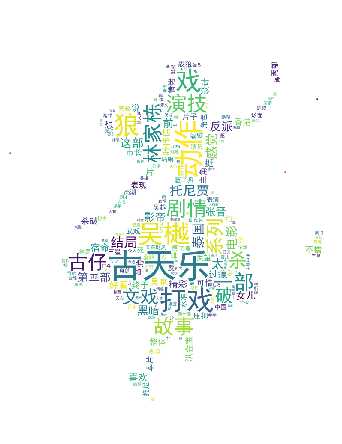python大作业,,利用python对豆
python大作业,,利用python对豆
利用python对豆瓣电影评价的爬取,并生成词云
一、抓取网页数据
第一步要对网页进行访问,python中使用的是urllib库。代码如下:
from urllib import requestresp = request.urlopen(‘https://movie.douban.com/nowplaying/hangzhou/‘)html_data = resp.read().decode(‘utf-8‘)
第二步,需要对得到的html代码进行解析,得到里面提取我们需要的数据。
在python中使用BeautifulSoup库进行html代码的解析。
BeautifulSoup使用的格式如下:
BeautifulSoup(html,"html.parser")
第一个参数为需要提取数据的html,第二个参数是指定解析器,然后使用find_all()读取html标签中的内容from bs4 import BeautifulSoup as bs soup = bs(html_data, ‘html.parser‘) nowplaying_movie = soup.find_all(‘div‘, id=‘nowplaying‘) nowplaying_movie_list = nowplaying_movie[0].find_all(‘li‘, class_=‘list-item‘)
在上图中可以看到data-subject属性里面放了电影的id号码,而在img标签的alt属性里面放了电影的名字,因此我们就通过这两个属性来得到电影的id和名称。(注:打开电影短评的网页时需要用到电影的id,所以需要对它进行解析),编写代码如下:
nowplaying_list = [] for item in nowplaying_movie_list: nowplaying_dict = {} nowplaying_dict[‘id‘] = item[‘data-subject‘] for tag_img_item in item.find_all(‘img‘): nowplaying_dict[‘name‘] = tag_img_item[‘alt‘] nowplaying_list.append(nowplaying_dict)
二、数据清洗
为了方便进行数据进行清洗,我们将列表中的数据放在一个字符串数组中,代码如下:
comments = ‘‘for k in range(len(eachCommentList)): comments = comments + (str(eachCommentList[k])).strip()
三、用词云进行显示
代码如下:
import matplotlib.pyplot as plt%matplotlib inlineimport matplotlibmatplotlib.rcParams[‘figure.figsize‘] = (10.0, 5.0)from wordcloud import WordCloud#词云包wordcloud=WordCloud(font_path="simhei.ttf",background_color="white",max_font_size=80) #指定字体类型、字体大小和字体颜色word_frequence = {x[0]:x[1] for x in words_stat.head(1000).values}word_frequence_list = []for key in word_frequence: temp = (key,word_frequence[key]) word_frequence_list.append(temp)wordcloud=wordcloud.fit_words(word_frequence_list)plt.imshow(wordcloud)
付源码:完整代码# -*- coding: utf-8 -*-import warningswarnings.filterwarnings("ignore")import jieba # 分词包import numpy # numpy计算包import codecs # codecs提供的open方法来指定打开的文件的语言编码,它会在读取的时候自动转换为内部unicodeimport reimport pandas as pdimport matplotlib.pyplot as pltfrom PIL import Imagefrom urllib import requestfrom bs4 import BeautifulSoup as bsfrom wordcloud import WordCloud,ImageColorGenerator # 词云包import matplotlibmatplotlib.rcParams[‘figure.figsize‘] = (10.0, 5.0)# 分析网页函数def getNowPlayingMovie_list(): resp = request.urlopen(‘https://movie.douban.com/nowplaying/hangzhou/‘) html_data = resp.read().decode(‘utf-8‘) soup = bs(html_data, ‘html.parser‘) nowplaying_movie = soup.find_all(‘div‘, id=‘nowplaying‘) nowplaying_movie_list = nowplaying_movie[0].find_all(‘li‘, class_=‘list-item‘) nowplaying_list = [] for item in nowplaying_movie_list: nowplaying_dict = {} nowplaying_dict[‘id‘] = item[‘data-subject‘] for tag_img_item in item.find_all(‘img‘): nowplaying_dict[‘name‘] = tag_img_item[‘alt‘] nowplaying_list.append(nowplaying_dict) return nowplaying_list# 爬取评论函数def getCommentsById(movieId, pageNum): eachCommentList = [] if pageNum > 0: start = (pageNum - 1) * 20 else: return False requrl = ‘https://movie.douban.com/subject/‘ + movieId + ‘/comments‘ + ‘?‘ + ‘start=‘ + str(start) + ‘&limit=20‘ print(requrl) resp = request.urlopen(requrl) html_data = resp.read().decode(‘utf-8‘) soup = bs(html_data, ‘html.parser‘) comment_div_lits = soup.find_all(‘div‘, class_=‘comment‘) for item in comment_div_lits: if item.find_all(‘p‘)[0].string is not None: eachCommentList.append(item.find_all(‘p‘)[0].string) return eachCommentListdef main(): # 循环获取第一个电影的前10页评论 commentList = [] NowPlayingMovie_list = getNowPlayingMovie_list() for i in range(10): num = i + 1 commentList_temp = getCommentsById(NowPlayingMovie_list[0][‘id‘], num) commentList.append(commentList_temp) # 将列表中的数据转换为字符串 comments = ‘‘ for k in range(len(commentList)): comments = comments + (str(commentList[k])).strip() # 使用正则表达式去除标点符号 pattern = re.compile(r‘[\u4e00-\u9fa5]+‘) filterdata = re.findall(pattern, comments) cleaned_comments = ‘‘.join(filterdata) # 使用结巴分词进行中文分词 segment = jieba.lcut(cleaned_comments) words_df = pd.DataFrame({‘segment‘: segment}) # 去掉停用词 stopwords = pd.read_csv("stopwords.txt", index_col=False, quoting=3, sep="\t", names=[‘stopword‘], encoding=‘utf-8‘) # quoting=3全不引用 words_df = words_df[~words_df.segment.isin(stopwords.stopword)] # 统计词频 words_stat = words_df.groupby(by=[‘segment‘])[‘segment‘].agg({"计数": numpy.size}) words_stat = words_stat.reset_index().sort_values(by=["计数"], ascending=False) # print(words_stat.head()) bg_pic = numpy.array(Image.open("alice_mask.png")) # 用词云进行显示 wordcloud = WordCloud( font_path="simhei.ttf", background_color="white", max_font_size=80, width = 2000, height = 1800, mask = bg_pic, mode = "RGBA" ) word_frequence = {x[0]: x[1] for x in words_stat.head(1000).values} # print(word_frequence) """ word_frequence_list = [] for key in word_frequence: temp = (key, word_frequence[key]) word_frequence_list.append(temp) #print(word_frequence_list) """ wordcloud = wordcloud.fit_words(word_frequence) image_colors = ImageColorGenerator(bg_pic) # 根据图片生成词云颜色 plt.imshow(wordcloud) #显示词云图片 plt.axis("off") plt.show() wordcloud.to_file(‘show_Chinese.png‘) # 把词云保存下来main() 
python大作业
相关内容
- Python字符串学习,,-- coding:
- Python内置函数之str(),,class str(
- python格式化函数foramt,,#通过位置print
- 用python写的自动转发邮件信息模板,,# -*- codi
- python3, 解析迅雷地址为原地址,,解析迅雷地址为原地址
- python实现dns查询,,dnspython模
- 在docker容器中部署python-selenium+chrome-headless自动化脚本
- Python 字符串格式化%与format() 函数 九,,这是12月规划的
- python自动化之函数封装,,前面一些记录了sel
- python分段计费demo,,根据以下信息提示,请
评论关闭